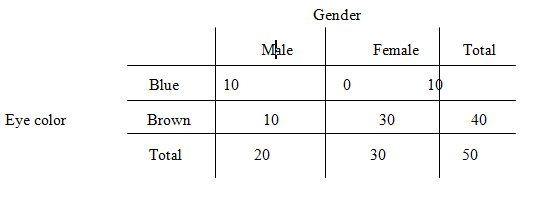
Concept explainers
(a)
Fill the two − way table such that A and B are mutually exclusive.
(a)
Answer to Problem 97E
Two − way table:

Explanation of Solution
Given information:
Data on gender and eye color of the students summarized in two − way table:

A: Student is male
B: Student has blue eyes
Two events are disjoint or mutually exclusive when both events cannot occur at same time.
In this part,
Events A and B are mutually exclusive.
This implies
No male student has blue eyes.
Thus,
In the table, put 0 in the column “Male” and row “Blue”.
Also,
Put the remaining counts according to the total counts of the rows and columns.
Thus,
The two − way table becomes:

(b)
Fill the two − way table such that A and B are independent.
(b)
Answer to Problem 97E
Two − way table:

Explanation of Solution
Given information:
Data on gender and eye color of the students summarized in two − way table:

A: Student is male
B: Student has blue eyes
Two events are independent, when the probability of occurrence of one
Then
The counts will be the product of the row total and the column total, divided by the table total provided in the bottom left corner of the table.
Calculate the counts in the two − way table:

Thus,
The two − way table becomes:

(c)
Fill the two − table such that A and B are not mutually exclusive and not independent.
(c)
Answer to Problem 97E
Two – way table:

Explanation of Solution
Given information:
Data on gender and eye color of the students summarized in two − way table:

A: Student is male
B: Student has blue eyes
For two − way table, where A and B are not mutually exclusive and not independent as well.
In this part, the count for male with blue eyes should be different from the other two parts (Part (a) and Part (b)).
Suppose, if we choose the count 10 for male with blue eyes.
Then
Put 10 in the column “Male” and the row “Blue”.
And
Put the remaining counts according to the total counts of the rows and columns.
Thus,
The two − way table becomes:

Chapter 5 Solutions
PRACTICE OF STATISTICS F/AP EXAM
Additional Math Textbook Solutions
Essentials of Statistics, Books a la Carte Edition (5th Edition)
Basic Business Statistics, Student Value Edition
Introductory Statistics
Statistical Reasoning for Everyday Life (5th Edition)
 MATLAB: An Introduction with ApplicationsStatisticsISBN:9781119256830Author:Amos GilatPublisher:John Wiley & Sons Inc
MATLAB: An Introduction with ApplicationsStatisticsISBN:9781119256830Author:Amos GilatPublisher:John Wiley & Sons Inc Probability and Statistics for Engineering and th...StatisticsISBN:9781305251809Author:Jay L. DevorePublisher:Cengage Learning
Probability and Statistics for Engineering and th...StatisticsISBN:9781305251809Author:Jay L. DevorePublisher:Cengage Learning Statistics for The Behavioral Sciences (MindTap C...StatisticsISBN:9781305504912Author:Frederick J Gravetter, Larry B. WallnauPublisher:Cengage Learning
Statistics for The Behavioral Sciences (MindTap C...StatisticsISBN:9781305504912Author:Frederick J Gravetter, Larry B. WallnauPublisher:Cengage Learning Elementary Statistics: Picturing the World (7th E...StatisticsISBN:9780134683416Author:Ron Larson, Betsy FarberPublisher:PEARSON
Elementary Statistics: Picturing the World (7th E...StatisticsISBN:9780134683416Author:Ron Larson, Betsy FarberPublisher:PEARSON The Basic Practice of StatisticsStatisticsISBN:9781319042578Author:David S. Moore, William I. Notz, Michael A. FlignerPublisher:W. H. Freeman
The Basic Practice of StatisticsStatisticsISBN:9781319042578Author:David S. Moore, William I. Notz, Michael A. FlignerPublisher:W. H. Freeman Introduction to the Practice of StatisticsStatisticsISBN:9781319013387Author:David S. Moore, George P. McCabe, Bruce A. CraigPublisher:W. H. Freeman
Introduction to the Practice of StatisticsStatisticsISBN:9781319013387Author:David S. Moore, George P. McCabe, Bruce A. CraigPublisher:W. H. Freeman





